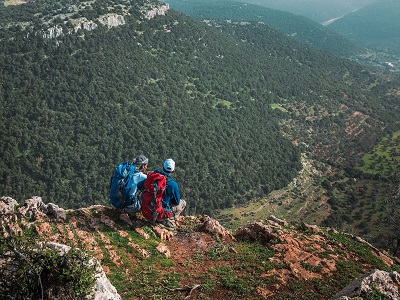In the most northerly and greenest part of Jordan, the hills and canyons are packed with the ruins of many ancient civilizations. The fertility of the hot Jordan Valley, the grasslands on the hills above it, and the oak forests of the highest mountains provide an enchanting natural backdrop to the trek between historic sites from the past two millennia and beyond. Hot springs, huge ancient olive trees, caves, mysterious prehistoric structures, Roman cities, and villages pioneering community-based tourism are some of the attractions of this northern corner of Jordan.

Main sites in the region:
- Ruins of Roman Decapolis cities at Um Qais and Pella
- Ecopark at Wadi Ziglab
- Byzantine monastery ruins at Tel Mar Elias, traditional birthplace of the prophet Elijah
- Community tourism and rural scenery in the al-Ayoun villages
- Mediaeval mountaintop site of Ajloun Castle
Ajloun can be reached from Amman or other large towns by public buses; as always in Jordan, these do not follow a schedule but leave when full. Transportation to the rest of the points on the trail is less reliable, though minibuses do run irregularly along the Jordan Valley highway, passing near Pella and the Ecopark. Private taxis are nearly always an option in the region. The bus journey between Amman and Ajloun is about 1.5 hours.
Accommodations are available throughout the region in the form of guesthouses or hotels at the Ecopark, near Pella, and in Ajloun; family stays are also available in Beit Idis and in particular in Orjan, Baoun, and Rasoun, where many families are prepared to host travellers. Family stays operate something like a bed-and-breakfast in a family’s home, including dinner and breakfast and a packed lunch, and are generally a very social experience. The al-Ayoun region is the hub of this form of community-based tourism in Jordan and offers a unique.Wild camping is also possible, particularly in the forested hills around the al-Ayoun area.

Umm Qais to Ziglab
It's so nice to begin downhill. Starting at the basalt ruins of the Decapolis of Um Qais overlooking the Sea of Galilee, we head down towards the Arab Dam, reaching Tel Zaraa at the water’s edge. We then follow the south side of the reservoir before climbing hills to a flat rich agriculture plain and the village of Zabda. Beyond, we drop down and follow Wadi Darraba and Quseiba to the west, finally heading south and crossing Wadi e Tayyiba to the Ziglab Lake and Eco Park.
Distance: 25.5 km
Time: 8 hours
Physical Challenge: Difficult
Trail Challenge: Difficult
Waymarked: Yes
Ziglab to Beit Idis
The way heads south from the Ecopark gate rising gently around hills directly above the sub sea level agricultural plain of the Jordan Rift Valley to which it briefly descends, passing by fields before rising into the hills. Continuing south, paths and tracks cross the hilltops before a good track descends SW to the hot springs and natural arch beyond which a country lane leads to the Greco-Roman ruins of Pella with the Rest House on the hill above and the Countryside Hotel and homestays in the village of Tabgat Fahl below. We continue up the side of the impressive valley of Wadi el Jirim directly behind the ruins to emerge through pine trees onto upland meadows. Still following the line of the valley up, now called Wadi Sir, you pass the ruins of a Byzantine Church and on to the ‘Jesus Cave’ before heading for the village of Beit Idis.
Distance: 22.4 km
Time: 8 hours
Physical Challenge: Difficult
Trail Challenge: Difficult
Waymarked: Yes
Beit Idis to Rasoun
Small lanes lead N out of the village and across the upper reaches of Wadi Sir to a road rising up through wooded countryside before descending NE into the beautiful and thickly wooded Wadi Zubia. Depending on the season there may be water in the stream. Follow the valley up until the trees thin out, revealing the cisterns and ruins of Roman Qabla up to the left. A lane then goes S up the hillside to where the main road is followed by W before descending a wooded valley and hillside and crossing Wadi Orjan to reach Rasoun village and homestays.
Distance: 15.2 km
Time: 4-6 hours
Physical Challenge: Moderate
Trail Challenge: Moderate
Waymarked: Yes
Rasoun to Ajloun castle
Generally easy walking, often on country lanes through the rural villages of Al Ayoun with opportunities for a pre-arranged lunch in one of Al Ayoun’s homestays. RSCN’s Soap House and Calligraphy house are also nearby for an interesting visit. Then the walk meanders over increasingly high semi-forested hills and past the ruins of the ancient church of Mar Elyas to the Islamic castle of Ajloun on its dominating hilltop with a Visitor Centre, cafés and hotels in the town below.
Distance: 16.9 km
Time: 4-5 hours
Physical Challenge: Moderate
Trail Challenge: Moderate
Waymarked: Yes
Source:
www.jordantrail.org